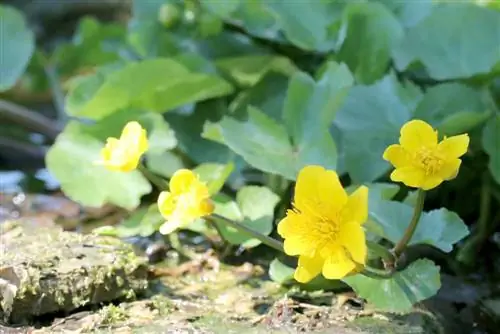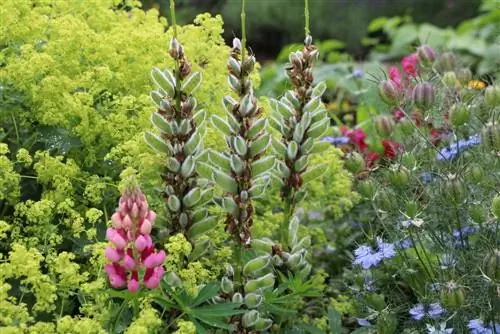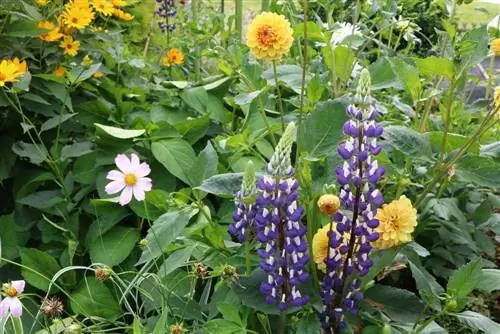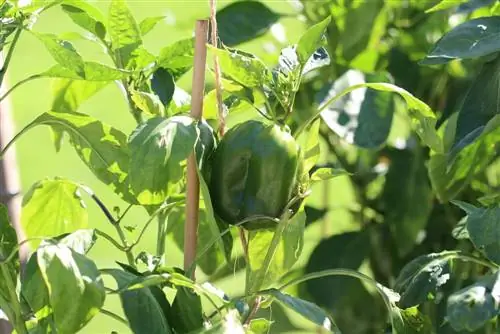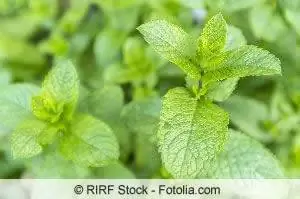- Author admin [email protected].
- Public 2023-12-17 03:39.
- Last modified 2025-06-01 06:48.
There are many varieties of marigold flowers, but what they all have in common is that they are very decorative because they bloom so much. The care, however, is quite simple, as is the propagation by sowing, which usually happens all by itself. If marigolds have been cultivated in the garden bed, they will be enjoyed for many years.
Care
Caring for student flowers is the same for all varieties and is quite simple. In this latitude, the marigold, when cultivated in the garden bed, is only an annual perennial because it is not hardy. But if you leave the dried flowers hanging in the fall, the seeds will fall off and the decorative flowers will sprout again next year. But it can also be helped with new sowing in the spring. Otherwise, there is not much to consider when caring for lush growth.
Location
Tagetes are used to dry and hot areas as they originally come from South America. Here they usually grow on unprotected slopes. Therefore they are rain and windproof. The ideal location for the student flowers looks like this:
- mostly sunny
- also in the midday sun
- in a bright garden bed
- as a bed border
- in the bucket on the sunny terrace
- or a south-facing balcony
If the perennials are to survive a winter, they are ideally cultivated in a bucket. This can be brought indoors in winter so that the marigolds are not exposed to frost. Marigolds, on the other hand, cultivated in the garden bed, die in a cold winter, but can be replanted again and again by sowing.
Tip:
Student flowers are well suited as a mixed culture in the garden bed. Because of their strong smell, they repel many pests that could harm other plants. The plants can be used against nematodes, whiteflies, ants and as a snail barrier around a bed.
Substrate & Soil
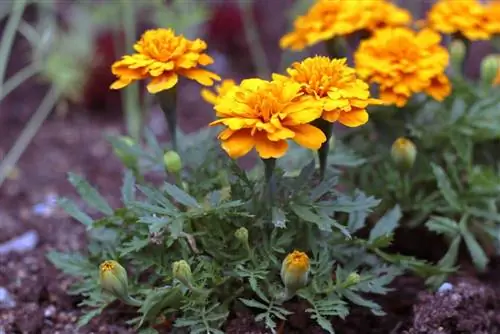
In order for the student flowers to fully bloom from early summer to autumn, they need permeable, humus-rich, nutrient-rich and always slightly moist soil. The ideal substrate looks like this:
- Garden soil mixed with compost and sand
- normal potting soil from the store for potted plants
- Prepare soil before sowing in spring
Fertilize
So that the marigolds can fully develop their flowers, they can be provided with fertilizer over the summer. If the bed or bucket was prepared with fresh soil before sowing, then no fertilization should be carried out in the first few weeks. When the first plants and flowers appear, liquid fertilizer for flowering plants can be added to the irrigation water every two weeks. Then a decorative carpet of flowers unfolds over the summer.
Pouring
Especially if the marigolds were cultivated in a location with full sun, they must always have enough water available. The soil should never dry out completely, but at the same time waterlogging should be avoided. Therefore, pay attention to the following when watering:
- water in the garden bed on hot days
- early morning or late evening hours
- on rainy days the rain is completely sufficient
- Potted plants should also be watered on rainy days
- Rainwater usually doesn't get into the bucket
Tip:
If the plants droop their green leaves, this is a sure sign that they need water. However, if they are then watered sufficiently immediately, they will recover quickly and will not be damaged.
Plants
Newly grown small plants are available in stores every spring, which can be planted directly into the garden bed after the Ice Saints in May. When planting, the following should be noted:
- Prepare soil in garden bed or border
- Dig planting hole
- Create drainage to prevent waterlogging
- to do this, put gravel in the planting hole
- Insert plants and distribute the soil
- Press well and pour in
Tip:
The plants can be placed close together so that no soil shows through in a bed border or in a garden bed. This does not prevent them from growing and a continuous flowering carpet is created, especially with the small growing varieties.
Sowing

If marigolds are already cultivated in the garden bed or a pot, then sowing them is very easy. The last flowers in autumn are not removed when they have faded but remain on the plant until they dry out. The seeds formed here can now be collected and set aside for next year. However, if the seeds are scattered directly onto the surrounding soil, new plants will also form next spring. This type of propagation is particularly successful in slightly warmer climates. Otherwise, the sowing procedure is as follows:
- store the collected seeds in a cool and dry place
- Prepare the seed pot in February or March
- Use growing soil
- Only insert seeds lightly
- these are light germinators
- Keep soil slightly moist
- Place the pot in a bright, warm place
- no full sun
- 20° Celsius is ideal
If the seedlings are large enough, they are transplanted into individual pots and left to stand in the warm location. The student flowers that have grown larger can then be planted in the desired location after the ice saints.
Tip:
The seeds can also be scattered directly into the garden bed in spring. But pre-growing in a pot gives you a head start on growth, because seeds sown in the bed will only start to germinate when it has warmed up accordingly.
Cultivate in a bucket
If you don't have a garden, you can also cultivate marigolds in a pot on the terrace or balcony. The decorative flowers do not require much space and can also be grown in a small pot. When planting or sowing, the procedure is the same as for marigolds cultivated in the garden bed. Normal potting soil for potted plants is completely sufficient for the plants here. Planting in containers also has the following advantage:
- Student flowers can be overwintered
- cut back close to the ground in autumn
- Place the pot in a cool, frost-free place
- for example in a stairwell
- it shouldn't be too dark
- water moderately and do not fertilize
- make it warmer in spring
- the plants are sprouting again
- out again in May after the Ice Saints
Plants grown in pots also require a lot of water, but should be protected from waterlogging. Therefore, drainage is created before filling in the soil. To do this, put potsherds or gravel over the drainage hole and then cover them with plant fleece. Only then is the substrate filled in.
Tip:
If you don't want to go to the trouble of overwintering in the pot, you can leave the pot outside, remove the plant in the fall after the first frost and reseed it in the spring.
Repotting

As a rule, marigolds are annual plants in these latitudes. But if they have been protected for several winters, they need a new substrate at least every two years. To do this, the plants are removed from the container before they sprout in spring, the soil is removed and new potting soil is added. The marigold is then placed in here again. Repotting because the plant has become too big is not necessary.
Cutting
It is not necessary to cut the marigolds. If they were cultivated in the garden bed, they die with the first frost and are disposed of with the roots. If the plants were grown in a pot and moved to a frost-free place in winter, the perennials should be cut back close to the ground, from where they will sprout again in spring. Otherwise, only the faded flowers of the marigold have to be removed regularly in summer to ensure new flowers.
Care errors, diseases or pests
There are no known care errors or diseases with the robust marigold flower. The only thing that can happen is that they have not been watered enough in a hot and dry summer and therefore dry out. This can easily happen while the garden owner is away on vacation. However, if it is too moist, mold or rot can occasionally occur. The easy-care plants are immune to pests except for snails. Young plants in particular are often attacked by snails, and slug pellets help against this.
Varieties
Over 60 varieties of the popular marigolds are known. There are low and tall growing varieties with double or unfilled flowers. The colors here all vary between yellow and dark orange. Three varieties are very often found in gardens in this latitude and are therefore the most popular among hobby gardeners:
“Tagetes erecta” - Upright Marigold
The upright marigold has a growth height of up to 80 cm. The jagged, 15 cm long and very dark green leaves are extremely decorative. The flowers can reach a diameter of up to 13 cm and look like flattened hemispheres. Tagetes erecta is also very popular as a cut flower in the vase because it lasts for a long time.
“Tagetes patula” - golden yellow student flower
The golden yellow marigold is a completely different species and is characterized primarily by the following:
- very small but lots of flowers
- only about six centimeters on average
- Color between yellow to orange-brown
- between full and half full
- Plant grows up to 60 cm high
- Leaves quite small
- is well suited for mixed culture or potted plants
- also in the vegetable patch
“Tagetes tenuifolia” - narrow-leaved marigold
The narrow-leaved marigold only grows up to thirty centimeters high, grows spherically and, above all, wide, as it can branch out widely. The flowers are also quite small, with a diameter of between two and three centimeters. However, its growth makes it appear very compact and with its many flowers it is reminiscent of a bright orange ball. This variety is also ideal as a ground cover.
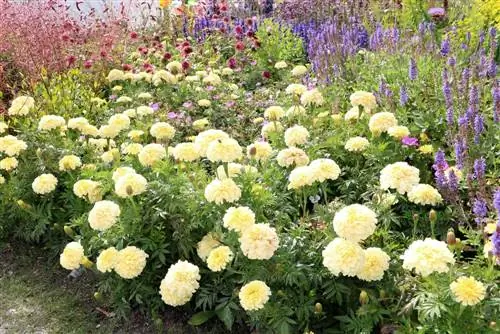
Other varieties
Of course, other decorative varieties of marigold flowers are also available as seeds or already finished plants in well-stocked garden shops. These include:
- Hybrids of “Tagetes erecta”
- Hybrid “Sperling's Eskimo”, new breed in creamy white
- Hybrid “Pollux Golden Yellow”, double double flowers, height up to 35 cm
- Hybrid “nana floro pleno Inca Yellow”, very large flowers, also available in orange
- Hybrid “Honey Bee”, blooms in honey yellow
- Hybrid “Goldstück”, grows very tall at 120 centimeters, lemon yellow flowers
- “Tagetes minuta”, giant spice marigold
- “Tagetes filifolia”, liquorice aroma
- “Tagetes nana”, very small plant height, suitable as a ground cover
Tip:
What may not be known to everyone is that all varieties of marigold flowers are edible. They have a sweet, fruity aroma with a taste of licorice or lemon. Therefore they can be used for many salads, but also in sweet dishes and to refine vinegar.


